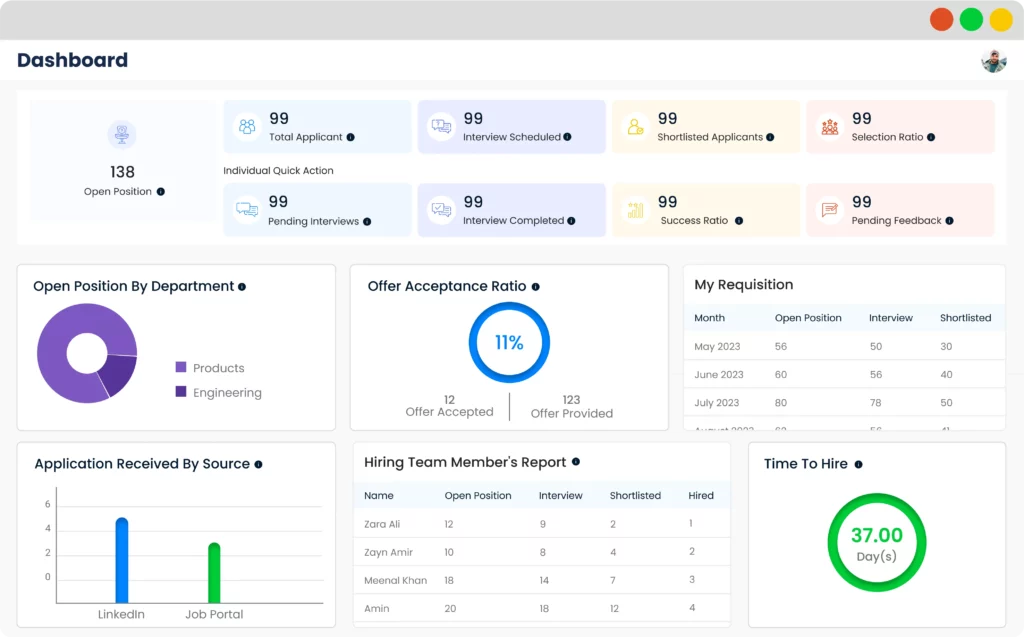
An Applicant Tracking System (ATS) is a software application designed to automate and streamline the recruitment process for employers. It serves as a centralized database for managing job openings, receiving and storing resumes and applications, and facilitating the hiring process from start to finish.
The primary purpose of an ATS is to help organizations manage large volumes of job applications efficiently. It provides a digital platform for recruiters and hiring managers to handle every stage of the recruitment process, including job posting, resume screening, candidate tracking, interview scheduling, and applicant communication.
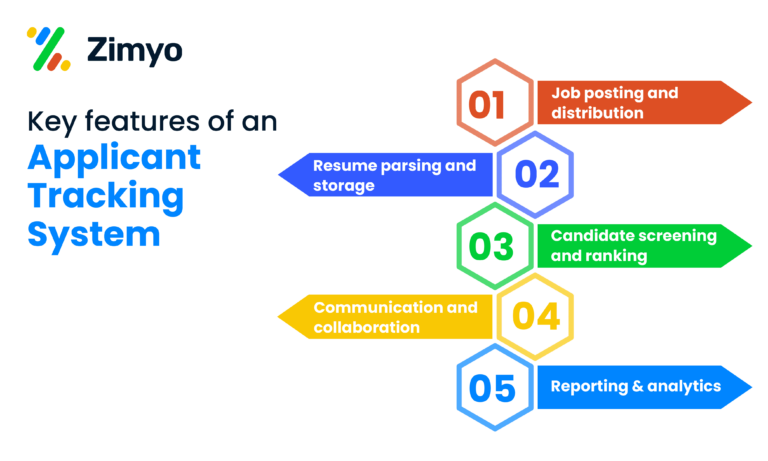
ATS allows employers to create and post job listings on various job boards and company websites. It also enables them to distribute job openings to multiple platforms simultaneously. Get the knowledge about the top job portals in India.
ATS automatically extracts relevant information from resumes and applications and stores them in a searchable database. This feature eliminates the need for manual data entry and makes it easier to find qualified candidates.
ATS uses keyword matching and other algorithms to filter resumes based on specified criteria. Recruiters can set up pre-defined requirements, such as education, experience, and skills, to identify the most suitable candidates for a particular position.
ATS provides tools for communication between recruiters and candidates, such as email templates, interview scheduling, and automated status updates. It also allows for internal collaboration among hiring team members, enabling them to share feedback and evaluate applicants collectively.
ATS generates reports and analytics on recruitment metrics, including time-to-fill, source of candidates, and diversity statistics. These insights help recruiters assess the effectiveness of their hiring strategies and make data-driven decisions.
The benefits of using an ATS include improved efficiency, time savings, better candidate management, enhanced collaboration, and a more streamlined hiring process. It enables organizations to handle high volumes of applications, reduce manual effort, and make more informed hiring decisions.
Overall, in ATS guide an applicant tracking system is a valuable tool for HR departments and recruitment teams to manage the entire recruitment lifecycle effectively and efficiently, from sourcing candidates to onboarding new hires.
The primary function of an Applicant Tracking System (ATS) mentioned in ATS guide is to store, analyze, and shortlist resumes based on qualifications and experience. To provide a comprehensive understanding, step by step process mentioned in ATS guide are:
Step 1: Recruitment professionals post job openings on various job boards and job posting sites. This entails providing detailed job descriptions and outlining the desired requirements for the position.
Step 2: Job seekers submit their resumes for the available positions.
Step 3: The ATS analyzes and stores the submitted information in a centralized database. It utilizes keywords and algorithms to scan and parse resumes and applications, extracting relevant details such as job titles, skills, and education. Additionally, hiring managers can employ the ATS to screen resumes and cover letters by comparing the provided information against the specified preferences for the open position.
Step 4: Resumes that meet the predetermined criteria are forwarded for further review, while those that do not meet the requirements are either rejected or placed in a separate database for future consideration.
Step 5: The organization’s hiring managers utilize the applicant tracking software to search and organize the information, facilitating the identification of the most suitable candidates.
Step 6: Selected candidates are scheduled for interviews by the hiring managers, enabling further assessment and ultimately the selection of the most appropriate candidate for the position.
In addition to tracking and managing job applications, Applicant Tracking Software includes features that enable communication with job seekers, the scheduling of interviews, and the tracking of applicants’ status throughout the hiring process. Some ATS systems also offer reporting and analytics capabilities, empowering recruiting teams to assess the effectiveness of their hiring processes and make data-driven decisions in the future.
Applicant Tracking Systems (ATS) are software applications designed to help recruiters and hiring managers streamline and automate the recruitment process. There are various types of ATS available, each with its own features and functionalities. According to ATS guide some common types of ATS used by recruiters are:
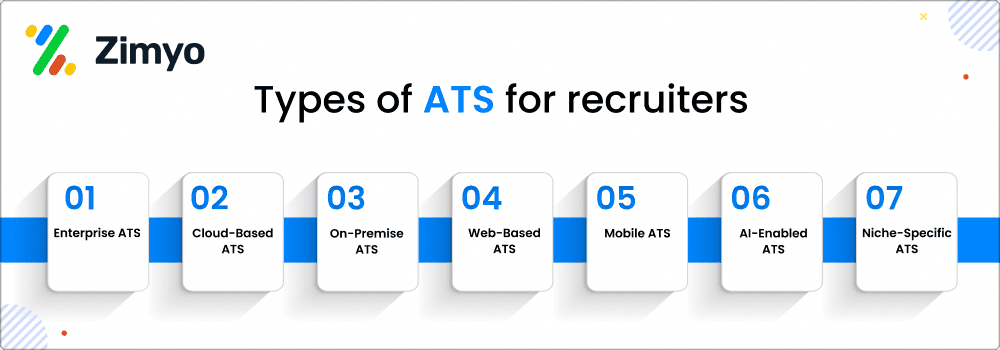
These ATS are hosted on the cloud, allowing recruiters to access and manage applicant data from any location with an internet connection. Cloud-based ATS often offer scalability, automatic updates, and data security.
Unlike cloud-based systems, on-premise ATS are installed and hosted on the recruiter’s own servers or infrastructure. This type of ATS provides more control and customization options but requires dedicated IT resources for maintenance and upgrades.
Web-based ATS are accessed through a web browser and require no installation. Recruiters can log in to the system from any device with internet access. They are typically easy to set up and use, making them suitable for small to medium-sized businesses.
Enterprise-level ATS are designed for large organizations with complex recruitment needs. These systems often have advanced features like multi-location support, high scalability, integration capabilities with other HR software, and robust reporting and analytics.
With the increasing use of smartphones, mobile ATS are becoming popular. These systems offer mobile-optimized interfaces and applications, allowing recruiters to manage the recruitment process on the go, review resumes, communicate with candidates, and perform other essential tasks using their mobile devices.
Artificial Intelligence (AI) has made its way into the recruitment process, and AI-enabled ATS leverages this technology to automate tasks such as resume screening, candidate matching, and interview scheduling. These systems use machine learning algorithms to improve efficiency and accuracy in candidate selection.
Some ATS are designed to cater to specific industries or niches. For example, there are ATS tailored for healthcare, IT, finance, or other specialized sectors. These systems often include industry-specific features, integrations with job boards, and compliance with relevant regulations.
It’s important to note that the features and capabilities of ATS can vary between providers. Recruiters should consider their specific needs, budget, scalability requirements, and integration possibilities when selecting an ATS for their organization.
An Applicant Tracking System (ATS) also differs from other HR tools in terms of its primary focus and specific functionality. While HR tools encompass a wide range of functions related to employee management and administration, an ATS is specifically tailored to streamline the hiring process and optimize recruitment activities.
Unlike general HR tools such as payroll software, as well as other aspects like benefits administration, or performance evaluation, an ATS concentrates on the applicant lifecycle. Its core features revolve around sourcing candidates, screening resumes, scheduling interviews, and managing candidate communication. This specialized focus allows an ATS to provide in-depth functionality and customization options specifically designed to enhance the recruitment process.
Moreover, an ATS offers robust automation and analytics capabilities that go beyond what traditional HR tools typically provide. It can automate repetitive tasks like resume parsing, application tracking, and interview scheduling, freeing up valuable time for HR professionals to focus on more strategic aspects of recruitment. Furthermore, an ATS generates comprehensive reports and analytics, enabling data-driven decision-making, monitoring key recruitment metrics, and identifying areas for improvement.
Overall, while general HR tools cater to a broader spectrum of HR functions, an ATS stands out by offering specialized features, automation, and analytics specifically tailored to optimize the recruitment process. Its ability to streamline candidate management, automate workflows, and provide data-driven insights makes it an essential tool for organizations seeking to enhance their hiring efficiency and find the best talent for their teams.
ATS (Applicant Tracking System) is used by various organizations and individuals involved in the recruitment and hiring process. Some of the key users mentioned in ATS guide are:
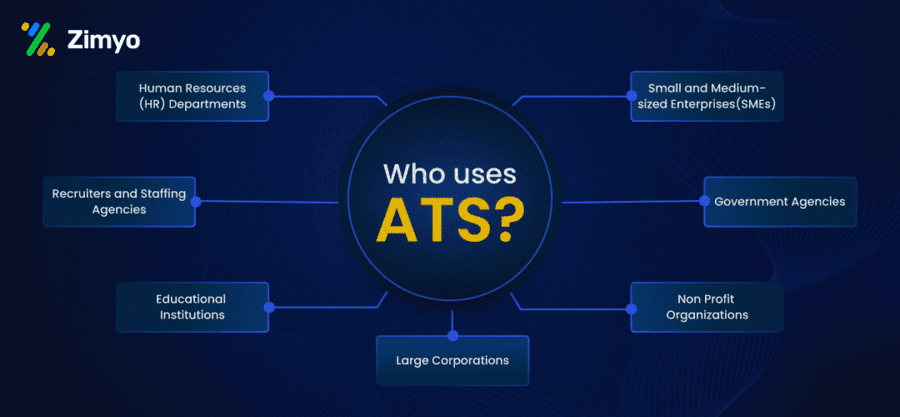
HR professionals use ATS to streamline their recruitment efforts, manage job postings, track applicants, and store candidate information.
Recruiters and staffing agencies utilize ATS to manage their candidate database, track job openings, match candidates to job requirements, and streamline the hiring process.
Many large companies and enterprises use ATS to handle high volumes of job applications, efficiently screen candidates, and automate various recruitment tasks.
ATS is also adopted by SMEs to enhance their hiring processes, save time and resources, and effectively manage job applications.
Universities, colleges, and schools often use ATS to manage faculty and staff recruitment, track applications for academic positions, and streamline the selection process.
Government organizations at various levels, such as federal, state, and local, may utilize ATS to manage their hiring processes, track applicants for job openings, and maintain candidate records.
Nonprofit organizations also make use of ATS to streamline their recruitment efforts, manage volunteer applications, and efficiently handle the hiring process.
These are just a few examples of the users of ATS. In general, any organization or individual involved in hiring or recruitment can benefit from using an ATS to streamline and optimize their hiring processes.
Its accuracy can vary depending on various factors, including the specific ATS software being used and how well it is configured and maintained by the company.
The accuracy of the software in matching candidates to job requirements depends on the effectiveness of the keywords and criteria used by the employer.
However, ATS software is not perfect and can have limitations. It may struggle with certain types of resumes or applications that are not formatted in a way that is easily scannable by the software. Additionally, some candidates may try to “game” the system by including excessive keywords or using formatting tricks to increase their chances of getting selected.
The accuracy of ATS software also depends on how well the software is configured and customized by the employer. Different companies have different hiring needs and may require specific criteria to be prioritized. If the software is not properly set up or lacks customization, it may produce inaccurate results.
Overall, while ATS software can be a useful tool for managing large volumes of applications, it’s important for employers to also review applications manually and ensure that qualified candidates are not overlooked due to limitations or inaccuracies of the software.
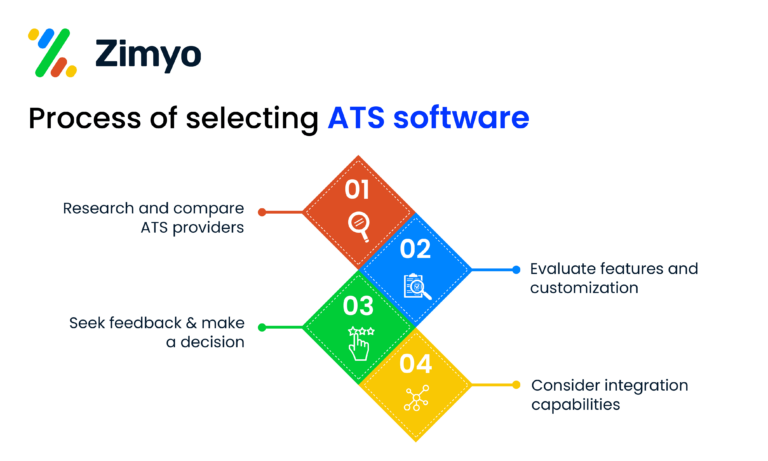
Understand your organization’s recruitment process and determine the key features you need in an ATS while considering your budget.
Conduct thorough research on reputable ATS providers, comparing factors like reputation, customer reviews, scalability, user-friendliness, and customer support.
Create a checklist of essential ATS features and functionalities, such as resume parsing, job posting, analytics, and customization options. Assess how well each ATS meets these criteria.
Determine if the ATS can integrate with your existing HR software and other systems, such as payroll or background screening tools, to streamline your recruitment processes.
Gather feedback from HR professionals, colleagues, and ATS vendor references. Based on your evaluations, narrow down your options and make a final decision on the ATS that best aligns with your organization’s needs.
According to ATS guide best Applicant Tracking Systems (ATS) typically have the following key features:
Advanced resume parsing capabilities that automatically extract relevant information from resumes and populate the ATS database, saving time and effort in manual data entry.
Seamless integration with job boards and social media platforms to enable easy job posting and broad distribution of job openings.
Tools to source candidates from various channels, including online job boards, career sites, social media platforms, and professional networking sites, to attract a diverse pool of qualified applicants.
Comprehensive candidate management functionalities to track and organize candidate information, including resumes, applications, communication history, interview notes, and feedback.
Flexible workflow management that allows you to design and customize the recruitment process based on your organization’s specific requirements, including automated notifications and reminders.
Built-in communication tools or integration with external email systems to facilitate collaboration among hiring managers, recruiters, and team members, enabling seamless communication throughout the hiring process.
Tools for screening and assessing candidates, such as skills assessments, pre-employment tests, and interview scheduling, to identify the most suitable candidates efficiently.
Robust analytics and reporting features that provide valuable insights into recruitment metrics, including time-to-fill, source effectiveness, candidate pipeline, and diversity statistics, enabling data-driven decision-making.
Integration with other HR systems, such as HRIS (Human Resources Information Systems), payroll software, and background screening services, to streamline data exchange and eliminate duplicate data entry.
Mobile-friendly interfaces or dedicated mobile apps that allow recruiters and hiring managers to access the ATS and manage recruitment tasks on the go.
Compliance with data protection regulations and industry standards, as well as features to ensure data security and privacy, including role-based access control, data encryption, and regular data backups.
It’s important to note that the best ATS for your organization will depend on your specific needs, budget, and size of your company. It’s advisable to thoroughly evaluate different ATS providers and consider factors like user reviews, customer support, pricing, and scalability before making a decision.
Zimyo’s ATS system begins by gathering candidates’ information, which may originate from submitted forms on websites, social media platforms, and other job listing websites. Subsequently, the ATS organizes, sorts, and filters the collected database, streamlining the screening process that would otherwise be time-consuming for HR professionals. By automating this process, the ATS saves significant time, allowing HR teams to focus on engaging with qualified candidates instead of manually reviewing each profile stored in spreadsheets and paper files. Additionally, the ATS possesses the capability to post job openings on both job boards and various social media channels, a feature known as omnichannel talent acquisition.
Zimyo stands out as one of the leading ATS systems in India, offering user-friendly and feature-rich solutions that simplify the hiring process for companies. Utilizing AI-driven recruitment software, Zimyo effectively identifies and recruits top-tier candidates from industry talent pools. Moreover, Zimyo seamlessly integrates with top job boards, enabling employers to swiftly post job openings across multiple platforms with just a single click.
In addition to its robust ATS functionality, Zimyo also provides a comprehensive suite of HR solutions, including HRMS, payroll management, performance management, and employee engagement software, among others. With over 40 modules, Zimyo offers a versatile range of services. The Zimyo mobile apps cater to both Android and iOS operating systems, ensuring accessibility and convenience for users.
Zimyo’s affordability makes it an ideal choice for small and medium enterprises. With a base pricing starting at ₹60 per month, the organization provides all the necessary services required by businesses. Users can easily upgrade to higher-tier packages based on their specific requirements.
The platform offers significant time and cost savings for recruiters, streamlining the hiring process. Furthermore, Zimyo features a real-time tracking service that promotes discipline and punctuality. The clean and intuitive user interface enhances usability and facilitates ease of understanding.
Numerous reputable organizations, including Bajaj Capital, Leena.AI, Yash Raj Films, TVF, and Collegedekho.com, have been long-term users of Zimyo, expressing high levels of satisfaction with the services provided.
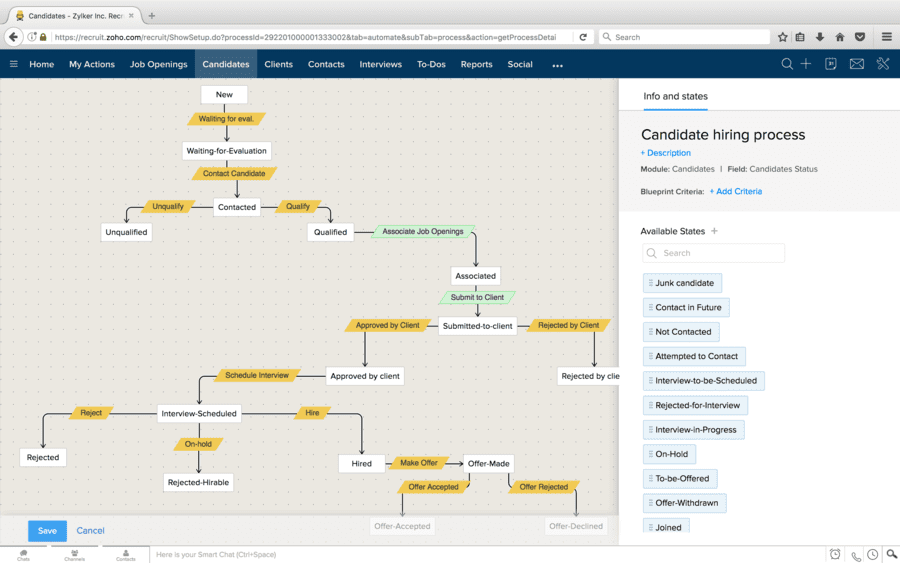
Zoho Recruit, also referred to as Zoho ATS, is an Applicant Tracking System (ATS) developed by Zoho Corporation. It serves as a comprehensive hiring management software solution for staffing agencies, temporary workforce recruiters, and corporate HR departments. With a wide range of features and tools, Zoho Recruit aims to streamline and optimize the recruitment process, making it more efficient and effective.
One of the standout features of Zoho Recruit is its powerful source booster, which enables recruitment agencies to easily identify and attract potential talent. The software provides a robust blueprint feature that guides recruiters through the entire recruitment process, ensuring that the right actions are taken in the correct order.
Moreover, Zoho Recruit allows companies to organize their recruitment teams based on product lines and geographical regions. This feature facilitates identifying areas with hiring needs, sharing accounts, and allocating resources appropriately. For temporary workforce recruiters, there is a dedicated portal within Zoho Recruit that enables tracking of upcoming jobs, completed projects, and ongoing assignments.
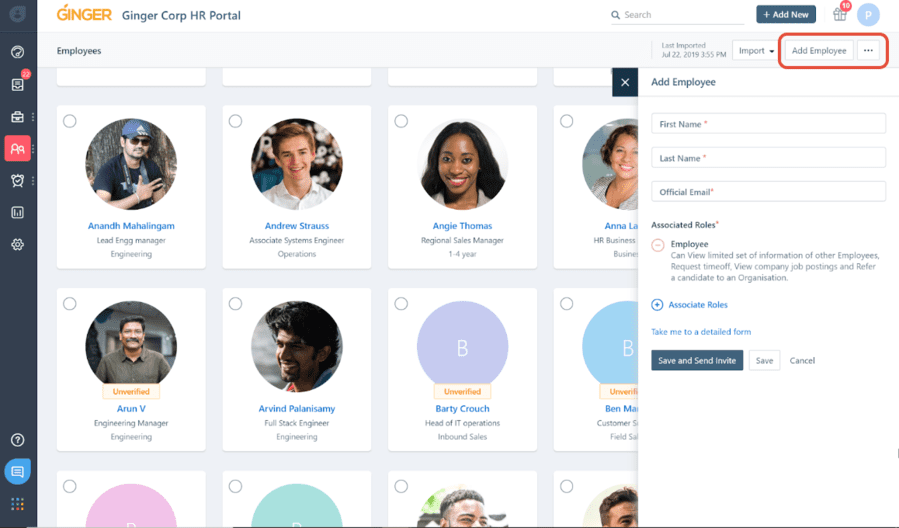
Freshteam is a cloud-based software solution aimed at modernizing human resources (HR) operations by consolidating the management of hiring, onboarding, time-off, employee data, and HR workflows within a unified platform. The company asserts that its software can significantly reduce workload by automating repetitive tasks, such as the evaluation and rejection of candidates who fail to meet specific requirements, advancing candidates who meet predefined criteria, sending notifications to all relevant stakeholders when candidates progress to the interview stage, archiving unselected candidates into a designated talent pool, and more.
Moreover, Freshteam offers intelligent candidate sourcing capabilities, enabling organizations to attract talent from diverse channels, including job boards, email campaigns, career portals, employee referrals, and social media platforms. By integrating with popular job boards such as Indeed, ZipRecruiter, LinkedIn, and Glassdoor, Freshteam enables companies to access a broad pool of potential candidates. The software also provides a selection of over 100 pre-designed job description templates, allowing companies to swiftly create and publish job postings. Additionally, Freshteam facilitates candidate screening through an automated résumé parser, enabling the analysis and identification of qualified candidates.
In conclusion, navigating the complex world of Applicant Tracking Systems (ATS) can be challenging, but armed with the right knowledge and strategies, you can greatly enhance your chances of success. Remember that while ATS technology plays a significant role in the hiring process, it is ultimately the human touch that seals the deal.
Throughout this guide, we have explored the inner workings of ATS and provided valuable insights to help you optimize your resume, cover letter, and overall application strategy. Remember, the purpose of an ATS is to streamline the hiring process and help employers identify top candidates efficiently. By understanding how ATS works and optimizing your application materials accordingly, you can increase your chances of getting noticed and securing the job you desire.
Treat ATS as your ally rather than a hurdle to overcome. With the right strategies, a polished application, and a sprinkle of perseverance, you can navigate the ATS landscape with confidence and find success in your job search. Good luck!
ATS, or Applicant Tracking System, is a cutting-edge software that streamlines and automates the hiring process. Designed to simplify recruitment, ATS efficiently filters and ranks job applications, saving valuable time for employers. With its advanced features like resume parsing and keyword matching, ATS ensures that qualified candidates stand out, optimizing the chances of finding the perfect fit. Employers now leverage ATS to enhance productivity and improve hiring outcomes, making it an indispensable tool in the competitive job market.
Improve hiring efficiency and streamline candidate management by utilizing an Applicant Tracking System (ATS). Automate manual tasks, such as job posting, screening, and interview scheduling, to save time and resources. With centralized data, easily search, filter, and compare applicants. Enhance the candidate experience, attract top talent, and make informed hiring decisions with an ATS.
Crafting an ATS-friendly CV is essential for modern job seekers. Start by using a clean and well-structured format with relevant keywords throughout. Optimize sections like work experience and skills with specific details and industry-related terms. Proofread thoroughly and save your CV in a compatible format, such as PDF, to ensure seamless parsing by Applicant Tracking Systems (ATS).
Understanding the distinction between an Applicant Tracking System (ATS) and a recruitment system is crucial for efficient talent acquisition. An ATS focuses on managing candidate applications, streamlining hiring processes, and enhancing candidate experience. Conversely, a recruitment system encompasses a broader scope, including applicant tracking, sourcing, onboarding, analytics, and more. Both systems play complementary roles in optimizing the end-to-end recruitment journey.
An Applicant Tracking System (ATS) is a powerful software tool used by companies to streamline and manage their recruitment process. It automates tasks like job posting, resume screening, and interview scheduling. By efficiently organizing candidate data, an ATS improves hiring efficiency and helps find the best-suited candidates for job openings.